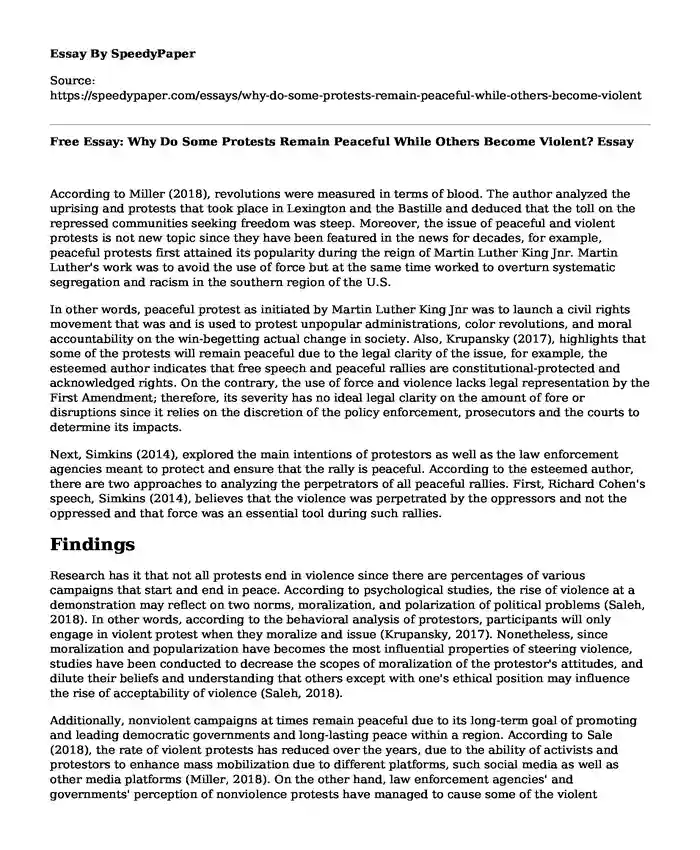
| Type of paper: | Research paper |
| Categories: | Violence Government Community Martin Luther King Social issue |
| Pages: | 3 |
| Wordcount: | 665 words |
According to Miller (2018), revolutions were measured in terms of blood. The author analyzed the uprising and protests that took place in Lexington and the Bastille and deduced that the toll on the repressed communities seeking freedom was steep. Moreover, the issue of peaceful and violent protests is not new topic since they have been featured in the news for decades, for example, peaceful protests first attained its popularity during the reign of Martin Luther King Jnr. Martin Luther's work was to avoid the use of force but at the same time worked to overturn systematic segregation and racism in the southern region of the U.S.
In other words, peaceful protest as initiated by Martin Luther King Jnr was to launch a civil rights movement that was and is used to protest unpopular administrations, color revolutions, and moral accountability on the win-begetting actual change in society. Also, Krupansky (2017), highlights that some of the protests will remain peaceful due to the legal clarity of the issue, for example, the esteemed author indicates that free speech and peaceful rallies are constitutional-protected and acknowledged rights. On the contrary, the use of force and violence lacks legal representation by the First Amendment; therefore, its severity has no ideal legal clarity on the amount of fore or disruptions since it relies on the discretion of the policy enforcement, prosecutors and the courts to determine its impacts.
Next, Simkins (2014), explored the main intentions of protestors as well as the law enforcement agencies meant to protect and ensure that the rally is peaceful. According to the esteemed author, there are two approaches to analyzing the perpetrators of all peaceful rallies. First, Richard Cohen's speech, Simkins (2014), believes that the violence was perpetrated by the oppressors and not the oppressed and that force was an essential tool during such rallies.
Findings
Research has it that not all protests end in violence since there are percentages of various campaigns that start and end in peace. According to psychological studies, the rise of violence at a demonstration may reflect on two norms, moralization, and polarization of political problems (Saleh, 2018). In other words, according to the behavioral analysis of protestors, participants will only engage in violent protest when they moralize and issue (Krupansky, 2017). Nonetheless, since moralization and popularization have becomes the most influential properties of steering violence, studies have been conducted to decrease the scopes of moralization of the protestor's attitudes, and dilute their beliefs and understanding that others except with one's ethical position may influence the rise of acceptability of violence (Saleh, 2018).
Additionally, nonviolent campaigns at times remain peaceful due to its long-term goal of promoting and leading democratic governments and long-lasting peace within a region. According to Sale (2018), the rate of violent protests has reduced over the years, due to the ability of activists and protestors to enhance mass mobilization due to different platforms, such social media as well as other media platforms (Miller, 2018). On the other hand, law enforcement agencies' and governments' perception of nonviolence protests have managed to cause some of the violent activities during these campaigns (Simpson et al., 2018). These entities perceive nonviolence protests as a passive force of resistance rather than a powerful tool of enhanced pro-active confrontation against discrimination, oppression, and racism, among other environmental and climatic disparities.
References
Krupansky, J., (2017, September 15). Spectrum of action, assembly, and protest from peaceful to violent. Retrieved from https://medium.com/@jackkrupansky/spectrum-of-action-assembly-and-protest-from-peaceful-to-violent-262421b03de6
Miller, Z. (2018, 12 January). Why Martin Luther King Jr.'s lessons about peaceful protests are still relevant. Retrieved from http://time.com/5101740/martin-luther-king-peaceful-protests-lessons/
Saleh, N. (2018, May 24). When do peaceful protests turn ugly? Researchers find that moral attitudes, as measured in tweets, predict violence. Retrieved from https://www.psychologytoday.com/us/blog/the-red-light-district/201805/when-do-peaceful-protests-turn-ugly
Simkins, C., (2014, January 20). Non-violence was key to the civil rights movement. Retrieved from https://www.voanews.com/usa/non-violence-was-key-civil-rights-movement
Simpson, B., Willer, R., & Feinberg, M., (2018). Does violent protest backfire? Testing a theory of public reactions to activist violence. Socius: Sociological Research for a Dynamic World, 1-14.
Cite this page
Free Essay: Why Do Some Protests Remain Peaceful While Others Become Violent?. (2023, Jan 23). Retrieved from https://speedypaper.net/essays/why-do-some-protests-remain-peaceful-while-others-become-violent
Request Removal
If you are the original author of this essay and no longer wish to have it published on the SpeedyPaper website, please click below to request its removal:
- Critical Essay Sample of the Movie The Wailing
- Biomedical Ethics Essay Example
- Essay Sample on General Electric Corporate Culture
- St. Sebastian's Health System, Essay Example for Students
- Free Paper with a Pharmacist's Resume Example
- Essay Sample on Marketing Plan for Whitespa Company
- Free Essay. Definitions of deviant behavior
Popular categories




